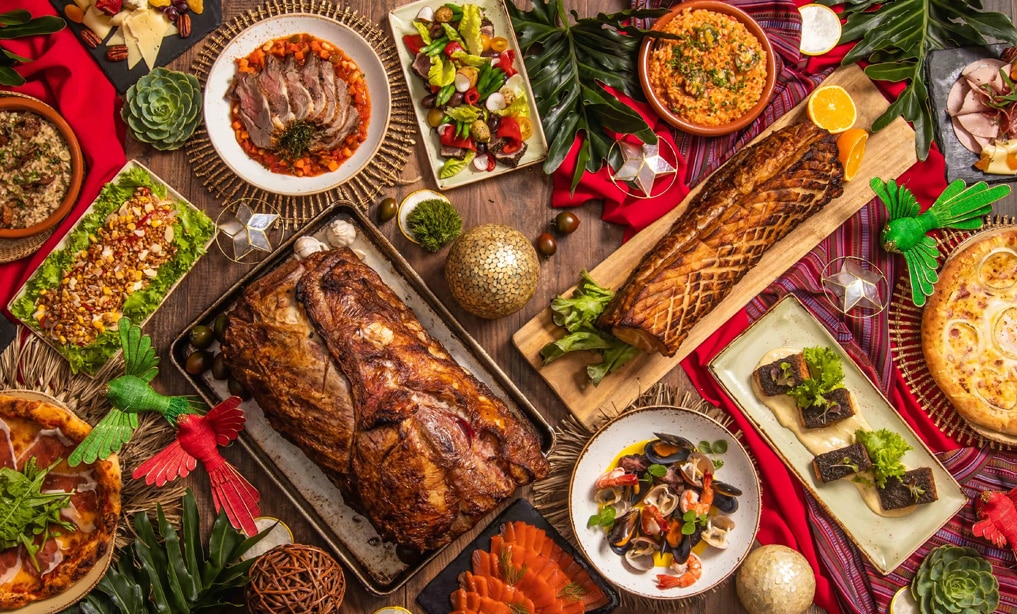CHRISTMAS is indeed very much around the corner and everything at this time gets just a little more festive. With families coming over, friends visiting and just everyone gathering for the holidays, it is clearly the most beautiful time of the year.
But besides Christmas travels and Christmas gifts, Christmas feasts are also weighing in on the holiday budget. We’re all guilty of over stretching the budget but before we spend on crazy gastronomic overloads, let’s make sure that we have the essentials lined-up and ready for the gram.
Noche Buena has been handed down by the Spaniards to the Filipinos through their long years of occupation. Celebrated on the eve of the 24th, it is a dinner feast enjoyed by the family usually after the mass to welcome the birth of Jesus Christ at the strike of 12 on the 25th.
And so here are some staple Noche Buena items that each Filipino Christmas table should never miss.
- Ham
The queen of every Filipino Christmas table hands down is a ball of sweet, syrupy ham. A Christmas ham is always the centerpiece at Noche Buena.
Stories have it that eating ham on Christmas started sometime in the 16th century when Spanish friars told Filipino Christians to fast on the evening of the birth of Jesus Christ – the good night or what’s known as the “Noche Buena.”
The fast then ends when the clock strikes 12 and a huge meal is served to seal it.
- Lechon
Another gastronomic delight every Christmas is “lechon” or a whole pig roasted over a searing hot charcoal bed. With its sheer size, it can feed the entire clan. Just like ham, serving lechon is likewise an age-old Christmas food tradition that’s ever present on most holiday celebrations.
Beware though, always eat lechon in moderation, as they say, Christmas too is the deadliest time of year.
Just the same, nothing beats crunching on crispy lechon skin with your loved ones and family this Christmas.
- Quezo de bola
Quezo de bola is another staple on the Christmas table. It is cheese shaped into a ball that’s coated with red wax. It is usually paired with wine to enjoy along with hearty chats with the family.
Eating this Instagram-worthy ball of cheese is also a tradition handed down from the Spaniards.
- Pasta
This had to be the most overrated but fool-proof Christmas food. It simply never gets old.
Everyone of all ages loves it from the kids down to the elderly and it’s also safe even if taken a little too much.
Plus, it’s a staple Filipino Christmas food that’s served over and over even after Christmas, hence the famous tradition called “pangat” a Pinoy slang used to define the act of repeatedly heating food.
- Salads
From fruit salads, to macaroni salads, to vegetable salads to practically every kind of salad possible, a hearty, cold, refreshing tub of salad always works for Christmas.
Adding a stunning pop of color into the Noche Buena table, salads aren’t only aesthetically appealing but mouth watering as well.
It’s usually the national dessert after a heavy Noche Buena.
- Barbecues
You just can’t miss a barbecue moment on every Filipino occasion. This is because Filipinos love meat.
Because pork barbecue in particular is very tasteful, it satisfies the palette very well. Whether over rice, pasta, or over beer, barbecues are among the perfect food to serve to show your love this Christmas.
- Bibingka and Puto Bumbong

When you see these sold on the streets, it’s officially the start of the Christmas season.
Bibingka and Puto Bumbong are rice cakes traditionally sold at the onset of the “ber” months to signify that the holidays are coming. Bibingka is a coconut cake baked in clay pots over live coals above and below it while Puto Bumbong is a purple treat steamed in bamboo tubes.
Among the kakanins, only Bibingka and Puto Bumbong enjoy an endearing and enduring connection to the Filipino holiday season.
As the Spaniards set in, among the traditions they introduced is the observance of the nine-day “simbang gabi” usually held between 3 am and 5 am. Because the masses are held in the wee hours, Filipinos need to consume a quick and easy breakfast that’s heavy enough to prepare them for the heavy work ahead.
Hence the start of the Bibingka and Puto Bumbong tradition.
Have you prepared your Christmas menu?








